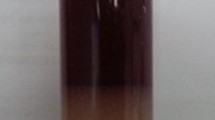Summary
The biochemical and the molecular diagnoses of an inherited porphyria require experience. False positive or negative screening tests and the low penetrance of the disease make a correct diagnosis difficult.The biochemical and the molecular procedures for the diagnosis of acute intermittent porphyria were applied to five unrelated patients suffering from acute intermittent porphyria. All patients were shown to be gene carriers of acute intermittent porphyria by both methods. The two different possibilities of the diagnosis corresponded well. In a family definitively identified by molecular diagnosis of one of the patients and his relatives, the patient’s two children were asymptomatic. His son was shown to be a gene carrier of the father’s deficiency by biochemical as well as molecular analysis, whereas his daughter was not affected by acute intermittent porphyria.
Similar content being viewed by others
References
Andersson C, Floderus Y, Wikberg A, Lithner F (2000) The W198X and R173W mutations in the porphobilinogen deaminase gene in acute intermittent porphyria have higher clinical penetrance than R167W. A population-based study. Scand J Clin Lab Invest 60: 643–648.
Bøyum A (1984) Separation of lymphocytes, granulocytes and monocytes from human blood using iodinated density gradient media. Methods Enzymol 108: 88–102.
Bradford MM (1976) A rapid and sensitive method for the quantitation of microgram quantities of protein utilizing the principle of protein–dye binding. Anal Biochem 72: 248–254.
von Brasch L, Zang C, Haverkamp T, Schlechte H, Heckers H, Petrides PE (2004) Molecular analysis of acute intermittent porphyria: mutation screening in 20 patients in Germany reveals 11 novel mutations. Blood Cells Mol Dis 32: 309–314.
Doss MO (1974) Porphyrins and porphyrin precursors. In: Curtius HC, Roth M, eds. Clinical Biochemistry – Principles and Methods, vol. 2. New York: W. de Gruyter, 1323–1371.
Doss MO, Sassa S (1994) The porphyrias. In: Noe DA, Rock RC, eds. Laboratory Medicine. The Selection and Interpretation of Clinical Laboratory Studies. Baltimore, MD: Williams and Wilkins, 535–553, 902–903.
Groß U, Honcamp M, Doss MO (1996) Heterogeneity of acute intermittent porphyria: a subtype with normal erythrocyte porphobilinogen deaminase activity in Germany. Eur J Clin Chem Clin Biochem 34: 613–618.
Groß U, Jacob K, Frank M, Doss MO (1997) Haem precursors and porphobilinogen deaminase in erythrocytes and lymphocytes of patients with acute intermittent porphyria. Cell Mol Biol 43: 29–35.
Groß U, Puy H, Doss M, et al (1999) New mutations of the hydroxy- methylbilane synthase gene in German patients with acute intermittent porphyria. Mol Cell Probes 14: 443–447.
Hessels J, Voortman G, van der Wagen A, van der Elzen C, Scheffer H, Zuijderhoudt FM (2004) Homozygous acute intermittent porphyria in a 7-year-old boy with massive excretions of porphyrins and porphyrin precursors. J Inherit Metab Dis 27: 19–27.
Higuchi R (1990) Simple and rapid preparation of samples for PCR. In: Innis MA, Geland DH, Sninsky JJ, White TJ, eds. PCR Protocols, New York: Academic Press, 177–183.
Hultdin J, Schmauch A, Wikberg A, Dahlqist G, Andersson C (2003) Acute intermittent porphyria in childhood: a population based study. Acta Paediatr 92: 562–568.
Kauppinen R (2004) Molecular diagnosis of acute intermittent porphyria. Expert Rev Mol Diagn 4: 243–249.
Mustajoki P (1981) Normal erythrocyte uroporphyrinogen I synthase in a kindred with acute intermittent porphyria. Ann Intern Med 95: 162–166.
Nordmann Y, Puy H, da Silva V, et al. (1997) Acute intermittent porphyria: prevalence of mutations in the porphobilinogen deaminase gene in blood donors in France. J Int Med 242: 213–217.
Periasamy V, al Shubaili A, Girsh Y (2002) Diagnostic dilemmas in acute intermittent porphyria. A case report. Med Princ Pract 11: 108–111.
Puy H, Deybach JC, Lamoril J, et al (1997) Molecular epidemiology and diagnosis of PBG deaminase gene defects in acute intermittent porphyria. Am J Hum Genet 60: 1373–1383.
Puy H, Groß U, Deybach JC, et al (1998) Exon 1 donor splice site mutations in the porphobilinogen deaminase gene in the non-erythroid variant form of acute intermittent porphyria. Hum Genet 103: 570–575.
Schuurmans MM, Schneider-Yin X, Rufenacht UB, et al (2001) Influence of age and gender on the clinical expression of acute intermittent porphyria based on molecular study of porphobilinogen deaminase gene among Swiss patients. Mol Med 7: 535–542.
Skriabina EN, Bogdanova TS (2002) Difficulties in diagnosis of intermittent porphyria. Klin Med 80: 70–71.
Author information
Authors and Affiliations
Corresponding author
Additional information
Communicating editor: Georg Hoffmann
Competing interests: None declared
Rights and permissions
About this article
Cite this article
Groß, U., Puy, H., Jacob, K. et al. Biochemical compared to molecular diagnosis in acute intermittent porphyria. J Inherit Metab Dis 29, 157–161 (2006). https://doi.org/10.1007/s10545-006-0155-9
Received:
Accepted:
Issue Date:
DOI: https://doi.org/10.1007/s10545-006-0155-9




